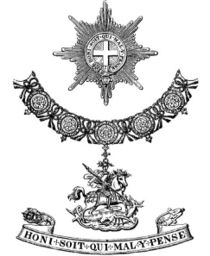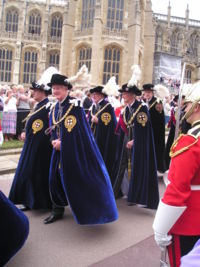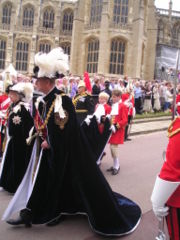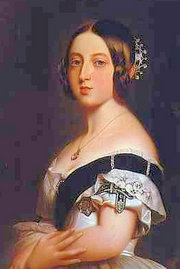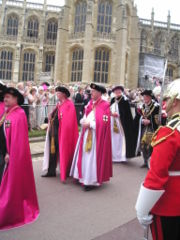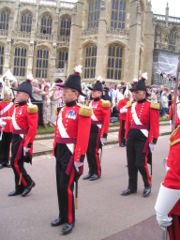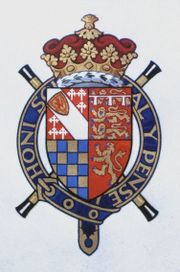Order of the Garter
From Wikipedia, the free encyclopedia
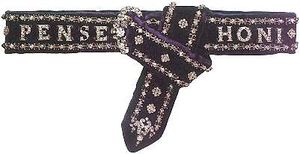
The Most Noble Order of the Garter is an English order of chivalry with a history stretching back to mediæval times; today it is the world's oldest national order of knighthood in continuous existence and the pinnacle of the British honours system. Its membership is extremely limited, consisting of the Sovereign and not more than twenty-five full members, or Companions. Male members are known as Knights Companion, whilst female members are known as Ladies Companion (not Dames, as in most other British chivalric orders). The Order can also include certain extra members (members of the British Royal Family and foreign monarchs), known as "Supernumerary" Knights and Ladies. The Sovereign alone grants membership to the Order; by convention the Prime Minister does not tender binding advice as to appointments, as he or she does for most other orders. Thus, membership of the order is regarded as being the Sovereign's gift. Except for the grants of supernumerary membership, awards are only made for those with an exceptional record of service to the United Kingdom.
As the name suggests, the Order's primary emblem is a garter bearing the motto Honi soit qui mal y pense (Old French for, "shame upon him who thinks evil of it") in gold letters. The Garter is an actual accessory worn by the members of the Order during ceremonial occasions. It is also depicted on several insignia, including British coins.
Most British orders of chivalry cover the entire kingdom, but the three most exalted ones each pertain to one constituent nation only. The Order of the Garter, which pertains to England, is most senior in both age and precedence; its equivalent in Scotland is The Most Ancient and Most Noble Order of the Thistle. While the Order of the Thistle was certainly in existence by the sixteenth century and possibly has mediæval origins (or even, according to legend, dates to the eighth century), the foundation of the institution in its modern form dates to 1687. In 1783 an Irish equivalent, The Most Illustrious Order of St Patrick, was founded, but since the independence of the greater part of Ireland the Order has fallen dormant (its last surviving knight died in 1974).
Contents |
[edit] History
The Order was founded in 1348 by King Edward III as "a society, fellowship and college of knights." Various dates ranging from 1344 to 1351 have also been proposed. The wardrobe account of the king first shows Garter habits issued in the autumn of 1348. Regardless, the Order was probably not constituted before 1346; the original statutes required that each member already be a knight (described currently as "knight bachelor") and several initial members of the Order were knighted then.
Various legends have been described to explain the origin of the Order. The most popular legend involves the "Countess of Salisbury" (possibly Joan of Kent). While she was dancing with or near King Edward at Eltham Palace, her garter is said to have slipped from her leg to the floor. When the surrounding courtiers sniggered, the king supposedly picked it up and tied it to his own leg, exclaiming "Honi soit qui mal y pense" (Shame on him who thinks evil of it). This phrase has become the motto of the Order. According to another legend, King Richard I was inspired in the 12th century by St George the Martyr while fighting in the Crusades to tie garters around the legs of his knights, who subsequently won the battle. King Edward III supposedly recalled the event in the 14th century when he founded the Order.
Soon after the founding of the Order, many women were appointed "Ladies of the Garter," but were not knighted as companions. King Henry VII stopped the practice in 1488 and created no more Ladies of the Garter after his mother Margaret Beaufort. The Order was thereafter exclusively male (except, of course, for the occasional female sovereign) until 1901, when King Edward VII created his wife Queen Alexandra a Lady of the Garter. The same occurred when King George V made his consort Queen Mary a Lady of the Garter and subsequently King George VI made his consort Queen Elizabeth also a Lady of the Garter. Throughout the 20th century, women continued to be associated with the Order, but except for foreign female monarchs, they were not companions. In 1987, however, it became possible to install "Ladies Companion of the Garter" under a statute of Queen Elizabeth II.
[edit] The Order
[edit] Members
Membership of the Order is extremely limited and includes the monarch of the United Kingdom, the Prince of Wales, not more than twenty-four companion members, and various supernumerary members. The monarch of the United Kingdom is known as the "Sovereign of the Garter" and the Prince of Wales is known as a "Knight Companion of the Garter." The monarch alone can grant membership.
Male members of the Order are known as "Knights Companion," while female ones are known as "Ladies Companion." Formerly, vacancies were filled by the Sovereign upon the nomination of the members. Each member would nominate nine candidates (of which three had to have the rank of Earl or higher, three the rank of Baron or higher, and three the rank of Knight or higher). The Sovereign would then choose as many nominees as were necessary to fill any vacancies that developed in the Order; he was not obliged to choose those who received the most nominations. Queen Victoria dispensed with the procedure in 1862. Appointments have since been made by the Sovereign acting alone, without any prior nominations.
Since the 18th century, the Sovereign made his or her choices upon the advice of the Government. However, King George VI believed in 1946 that the Order of the Garter and the Order of the Thistle had become too linked with political patronage. With the agreement of the Prime Minister and the Leader of the Opposition, membership of these two orders became a personal gift of the Sovereign. Thus, the Sovereign personally selects Knights and Ladies Companion of the Garter, and need not act upon the advice of the Government.
In addition, the Order includes several "supernumerary" members, who do not count towards the limit of twenty-four companions. Several supernumerary members belong to the royal family; these members are known as "Royal Knights and Ladies of the Garter." This title was introduced in 1786 by King George III so that his many sons would not count towards the limit of twenty-four companions. He created the statute of supernumerary members in 1805 so that any descendant of King George II could be created such a member. This statute was extended again in 1831 to all descendants of King George I.
Supernumerary membership may also be extended to foreign monarchs, who are known as "Stranger Knights and Ladies of the Garter." Every such installation originally required the enactment of a statute; however, a statute of 1954 authorises the regular admission of Stranger Knights or Ladies without further special enactments. The first such appointment came in 1813, when Emperor Alexander I of Russia was made a Stranger Knight.
The Sovereign may "degrade" members who have committed serious crimes such as treason. During the First World War, several Stranger Knights who were monarchs of enemy nations were removed by the "annulment" of their installations. Thus, for example, the appointments of Emperor Wilhelm II of Germany and Emperor Franz Joseph I of Austria were annulled in 1915. Emperor Hirohito of Japan similarly had his membership of the order removed after Japan's entry into World War II, he was however re-appointed to the order by Elizabeth II in the post war years. Hirohito therefore uniquely was made a Knight of the Garter twice by different Sovereigns.
[edit] Officers
The Order has six officers: the Prelate, the Chancellor, the Registrar, the Garter Principal King of Arms, the Usher, and the Secretary. The offices of Prelate, Registrar and Usher were created upon the order's foundation; those of Garter Principal King of Arms and Chancellor, during the 15th century; and that of Secretary, during the 20th century.
The office of Prelate is held by the Bishop of Winchester, traditionally one of the senior bishops of the Church of England. The office of Chancellor is held by one of the companions of the order. It was held formerly by the bishop of the diocese within which Windsor Castle existed: at one point, the Bishop of Salisbury, but after boundary changes, the Bishop of Oxford. Later, the field of potential appointees was widened so that, for example, the Stuart courtier Sir James Palmer served as Chancellor from 1645 although he was neither a prelate nor even a member of the Order (although he was a Knight Bachelor). Since the office ceased to be held by the Bishops of Oxford in 1937, the following members have held the post of Chancellor:
- The Duke of Portland (1937–1943)
- The Earl of Halifax (1943–1959)
- The Marquess of Salisbury (1960–1972)
- The Viscount Cobham (1972–1977)
- The Marquess of Abergavenny (1977–1994)
- The Lord Carrington (since 1994)
The office of Registrar is held by the Dean of Windsor. The position of Garter Principal King of Arms is held by the senior officer of the College of Arms (the heraldic authority of England). As the title suggests, Garter Principal King of Arms has specific duties as the officer of arms of the Order, attending to the companions' crests and banners of arms which are exhibited in the chapel. The Secretary is selected from the other officers of the College of Arms, and the office of Usher is held by the Gentleman Usher of the Black Rod who is also the Serjeant-at-Arms of the United Kingdom House of Lords (although his functions are more often performed there by his deputy, the Yeoman Usher).
[edit] Military Knights of Windsor
At the founding of the Order of the Garter, twenty-six "poor knights" were appointed and attached to the Order and its chapel. The number was not always maintained, and by the 17th century, there were only thirteen such knights. King Charles II increased the number to eighteen after his coronation in 1660. After the knights objected to being termed "poor", King William IV redesignated them in the 19th century as the Military Knights of Windsor.
The poor knights or military knights were originally impoverished military veterans. They were required to pray daily for the Knights Companion. In return, they received a salary and were lodged in Windsor Castle. The knights are no longer necessarily poor, but are still military pensioners. They participate in the Order's processions and escort the members, and in the chapel services. However, they are not considered knights or members of the Order.
[edit] Vestments and accoutrements
[edit] Members
For ceremonial occasions of the Order such as the annual Garter Day, the members wear elaborate vestments and accoutrements (or accessories), many of which were designed in 1821 for the coronation of King George IV:
- The mantle is a vestment or robe which members have worn since the 15th century. Once made of wool, it had come to be made of velvet by the 16th century. The mantle was originally purple, but varied during the 17th and 18th centuries between celestial blue, pale blue, royal blue, dark blue, violet and ultramarine. Mantles are now dark blue in colour and lined with white taffeta. The mantles of the Sovereign, the Prince of Wales, Royal Knights and Ladies end in trains. The heraldic shield of St George's Cross encircled by the Garter is sewn onto the left shoulder of the mantle, except that the Sovereign's mantle has the star of the Order instead. Attached to the mantle over the right shoulder are a dark-red velvet hood and surcoat which have lost all function over time and appear to the modern observer simply as a splash of colour.
- The hat is of black velvet with a plume of white ostrich and black heron feathers.
- The collar is an accessory which is worn around the neck over the mantle and, like the mantle, was introduced in the 15th and 16th centuries. Made of pure gold, it weighs 30 troy ounces (0.933 kg). The collar is composed of gold knots alternating with enamelled medallions showing a rose encircled by the Garter. During King Henry VII's reign, each garter surrounded two roses -- one red and one white -- but he changed the design such that each garter encircled only one red rose.
- The George which is worn suspended from the collar is a colourfully enamelled three-dimensional figurine of St George the Martyr on horseback slaying a dragon.
- The Garter is worn on ceremonial occasions around the left calf by knights and the left arm by ladies, and is depicted on several insignia. As the name of the Order suggests, its primary symbol is the Garter that is a buckled dark-blue (originally light-blue) velvet strap and bears the motto in gold letters. The garters of Stranger Knights and Ladies were once set with several jewels.
For other occasions when decorations are worn, the members wear simpler insignia:
- The collar is worn on designated "collar days" over military uniform or evening wear by members attending formal events. The collar is fastened to the shoulders with silk ribbons. Since the collar signifies the Order of the Garter, members can then wear the riband of any other order to which they belong.
- The star, which is worn pinned to the left breast, was introduced in the 17th century by King Charles I and is a colourfully enamelled depiction of the heraldic shield of St George's Cross, encircled by the Garter, which is itself encircled by an eight-point silver badge. Each point is depicted as a cluster of rays with the four points of the cardinal directions longer than the intermediate ones. The stars of Stranger Knights and Ladies were once set with several jewels. Since the Order of the Garter is the senior order of the United Kingdom, a member will wear its star above others (up to three) which he holds.
- The riband is a 4-inch (10.16 cm) wide sash worn over the left shoulder, or pinned beneath it, to the right hip, and was introduced in the 17th century by King Charles II. The riband's colour has varied over the years: it was originally light blue, but was a dark shade under the Hanoverian monarchs. In 1950, the colour was fixed as "kingfisher blue." A member will wear only one riband, even if he or she belongs to several orders.
- The badge is worn suspended from a small gold link from the riband at the right hip and is sometimes known as "the Lesser George". Like the George, the badge shows St George the Martyr on horseback slaying a dragon, but is flatter and gold. In the 15th century, the badge was worn attached to a ribbon around the neck. As this was not convenient when riding a horse, the custom of wearing it with a riband under the right arm developed.
On the death of a member, the badge and star are returned personally to the Sovereign by the former member's nearest male relative, and the other insignia to the Central Chancery of the Orders of Knighthood. .
[edit] Officers
For ceremonial occasions of the Order, the officers wear the following garments and accessories:
- The mantles for the prelate and chancellor are dark blue like those of the members (as a member, the chancellor wears a member's mantle), but the mantles for the other officers are dark red. All mantles are embroidered with a heraldic shield of St George's Cross. For Garter ceremonies Garter Principal King of Arms wears this red mantle rather than the tabard of the royal arms worn for other State ceremonial.
- Officers wear badges of office suspended from a chain worn around the neck. The badge for the prelate shows the Lesser George encircled by the Garter which is surmounted by a bishop's mitre. The badge for the chancellor is a rose encircled by the Garter. The badge for the register is two crossed quills over a book encircled by the Garter surmounted by a crown. The badge for Garter Principal King of Arms is the royal arms impaled with St George's Cross encircled by the Garter and surmounted by a crown. The badge for the usher is a knot (like those on the Collars of the companions of the order) encircled by the Garter surmounted with the crown. The badge for the secretary shows two crossed quills in front of a rose and encircled by the Garter surmounted with the crown.
The chancellor carries a purse which is embroidered with the royal arms impaled by the Cross of St. George. The purse contains the seal of the Order. Garter Principal King of Arms carries his baton of office. The usher carries his staff of office, the Black Rod.
[edit] Military knights of Windsor
The poor knights originally wore red mantles, each of which bore St George's Cross, but did not depict the Garter. Queen Elizabeth I replaced the mantles in the 16th and 17th centuries with blue and purple gowns, but the red mantles returned in the 17th century under King Charles I. When the knights were renamed, the mantles were abandoned. The military knights now wear the old military uniform of an "army officer on the unattached list": black trousers with red stripe, a red double-breasted swallow-tailed coat, gold epaulets and brushes, a cocked hat with a plume, and a sword on a white sash.
[edit] Precedence and privileges
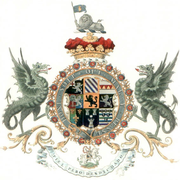
Members are assigned positions in the order of precedence
coming before all others of knightly rank and above baronets. The wives, sons,
daughters and daughters-in-law of Knights Companion are also assigned
precedence. Relatives of Ladies Companion are not, however, assigned any special
positions. (Generally, individuals can derive precedence from their fathers or
husbands but not from their mothers or wives.) The Chancellor is also assigned
precedence, but this is purely academic since the Chancellor is always a member
of the Order, and thereby has a higher position in the order of precedence. In
fact, it is unclear whether the Chancellor's tabled precedence has ever come
into effect, since under the old system the office was filled by a diocesan
bishop of the Church of England, who
again had a higher precedence by virtue of that office than any that the
chancellorship could bestow)
Knights Companion prefix "Sir" and Ladies Companion prefix "Lady" to their forenames. Wives of Knights Companion may prefix "Lady" to their surnames, but no such privilege exists for husbands of Ladies Companion. Such forms are not used by princes and peers, except when peers' names are written out in their fullest forms.
Knights and Ladies Companion use the post-nominal letters "KG" and "LG" respectively. When an individual is entitled to use multiple post-nominal letters, those of the Order of the Garter appear before all others except "Bt" (Baronet), "VC" (Victoria Cross) and "GC" (George Cross).
The members may encircle their arms with the Garter, and, if they wish, with a depiction of the collar as well. However, the Garter is normally used alone; the more elaborate version is seldom seen. Stranger Knights and Ladies do not, of course, embellish the arms they use in their countries with English decorations.
Knights and Ladies Companion are also entitled to receive heraldic supporters, a privilege granted to few other private individuals. While some families claim supporters by ancient use, and others have been granted them as a special reward, only peers, Knights and Ladies Companion of the Garter, Knights and Ladies of the Thistle, and certain other knights and ladies are automatically entitled to them.
[edit] Garter service
The Order of the Garter once held frequent services at St George's Chapel, Windsor Castle, but they became rare in the eighteenth century. Discontinued after 1805, the ceremony was revived by King George VI in 1948 and it has become an annual event. On a certain day each June, the members of the Order (wearing their ceremonial vestments and insignia) meet in the state apartments in the Upper Ward of Windsor Castle, then (preceded by the Military Knights of Windsor) process on foot down through the castle to St George's Chapel for the service. If there are any new knights, they are installed on this occasion. After the service, the members of the Order return to the Upper Ward by carriage.
[edit] Current members and officers
[edit] Sovereign
- Her Majesty The Queen Elizabeth II (1952)
[edit] Knights and Ladies Companion
- His Grace The Duke of Grafton KG DL (1976)
- The Rt Hon. The Lord Richardson of Duntisbourne KG MBE TD PC DL (1983)
- The Rt Hon. The Lord Carrington KG GCMG CH MC PC JP DL (1985)
- His Grace The Duke of Wellington KG LVO OBE MC DL (1990)
- Field Marshal The Rt Hon. The Lord Bramall KG GCB OBE MC JP (1990)
- The Rt Hon. The Viscount Ridley KG GCVO TD (1992)
- The Rt Hon. The Lord Sainsbury of Preston Candover KG (1992)
- The Rt Hon. The Lord Ashburton KG KCVO DL (1994)
- The Rt Hon. The Lord Kingsdown KG PC (1994)
- The Rt Hon. Sir Ninian Stephen KG AK GCMG GCVO KBE (1994)
- The Rt Hon. The Baroness Thatcher LG OM PC FRS (1995)
- Sir Edmund Hillary KG ONZ KBE (1995)
- Sir Timothy Colman KG JP (1996)
- His Grace The Duke of Abercorn KG (1999)
- Sir William Gladstone of Fasque and Balfour Bt KG DL (1999)
- The Rt Hon. The Lord Inge KG GCB DL (2001)
- Sir Antony Acland KG GCMG GCVO (2001)
- His Grace The Duke of Westminster KG OBE TD DL (2003)
- The Rt Hon. The Lord Butler of Brockwell KG GCB CVO PC (2003)
- The Rt Hon. The Lord Morris of Aberavon KG PC QC (2003)
- The Rt Hon. Sir John Major KG CH (2005)
- The Rt Hon. The Lord Bingham of Cornhill KG PC (2005)
- The Rt Hon. The Lady Soames LG DBE (2005)
There is one vacancy.
[edit] Royal Knights and Ladies
- His Royal Highness The Duke of Edinburgh KG KT OM GBE AC QSO PC (1947)
- His Royal Highness The Prince of Wales KG KT GCB OM AK QSO SOM PC ADC (1958)
- His Royal Highness The Duke of Kent KG GCMG GCVO (1985)
- Her Royal Highness The Princess Royal LG LT GCVO QSO GCL CD (1994)
- His Royal Highness The Duke of Gloucester KG GCVO (1997)
- Her Royal Highness Princess Alexandra LG GCVO CD (2003)
- His Royal Highness The Duke of York KG KCVO ADC(P) (2006)
- His Royal Highness The Earl of Wessex KG KCVO SOM ADC(P) (2006)
[edit] Stranger Knights and Ladies
- His Royal Highness The Grand Duke Jean of Luxembourg (1972)
- Her Majesty The Queen of Denmark (1979)
- His Majesty The King of Sweden (1983)
- His Majesty The King of Spain (1988)
- Her Majesty The Queen of the Netherlands (1989)
- His Imperial Majesty The Emperor of Japan (1998)
- His Majesty the King of Norway (2001)
[edit] Officers
- Prelate: The Right Reverend Michael Scott-Joynt (Lord Bishop of Winchester)
- Chancellor: The Right Honourable The Lord Carrington KG GCMG CH MC PC DL
- Registrar: The Right Reverend David Conner (Dean of St George's Chapel)
- Garter Principal King of Arms: Peter Llewellyn Gwynn-Jones CVO
- Secretary: Patric Laurence Dickinson Esq. LVO (Richmond Herald of Arms in Ordinary)
- Usher: Sir Michael Willcocks KCB (Gentleman Usher of the Black Rod)
[edit] References
- Elias Ashmole: Institution, Laws and Ceremonies of the Most Noble Order of the Garter. 1672.
- Begent, P.J. and Chesshyre, H. The Most Noble Order of the Garter: 650 Years. Spink and Son Ltd. 1999.
- Brennan, I.G. "The Most Noble Order of the Garter." HeraldicSculptor.com. 2004.
- Churchill Society London. "The Most Noble Order of the Garter." Churchill-Society-London.org.uk. 2004.
- Cox, N. "The ceremonial dress and accouterments of the Most Noble Order of the Garter." Heraldry News. Vol. 22, pp. 6-12 and vol. 23, pp. 7-11. 1999.
- "Knighthood and Chivalry." Encyclopedia Britannica. 11th ed. Cambridge University Press. 1911.
- Royal Household at Buckingham Palace. "Order of the Garter." Royal.gov.uk. 2005.
- Velde, F.R. "Order of Precedence in England and Wales." 2003.
[edit] External link
[edit] See also
- List of Knights and Ladies of the Garter
- List of Ladies of the Garter
- St George's Chapel at Windsor Castle
- The Society of the Friends of St George's and Descendants of the Knights of the Garter
- Windsor Castle
- Eltham Palace
| British honours system |
|---|
| Current Orders Garter | Thistle | Bath | St Michael and St George | Distinguished Service | Royal Victorian | Merit | Imperial Service | British Empire | Companions of Honour |
| Old Orders St Patrick | Royal Guelphic | Star of India | Indian Empire | Crown of India | Victoria and Albert |
| Other Honours and Appointments Hereditary peer | Life peer | Privy Counsellor | Baronet | Knight | St John | Other orders and decorations |
